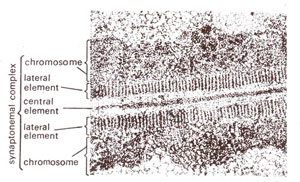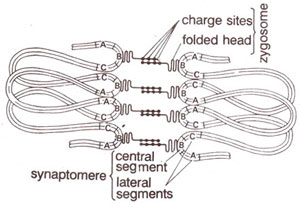Moses in 1956 first discovered synaptonemal complex (SC), a feature of meiotic prophase. Synaptonemal complex is a tripartite structure usually found between the two paired homologous chromosomes of each bivalent in all animal and plant nuclei undergoing meiosis. This is considered to be a physical structure which is associated with synapsis of homologous chromosomes. Complete synaptonemal complexes are seen at zygonema in the region of pairing. At pachynema these complexes are even more conspicuous.

Fig. 7.13. A bivalent with a synaptonemal complex showing central element and lateral elements (drawn from an electron photomicrograph).
Structure of synaptonemal complex. The synaptonemal complex is a configuration in which the lOnm fibres of the chromosomes are arranged into a superstructure that can be viewed under the electron microscope. It is composed of three parallel, electron dense elements that are separated by less dense areas (Fig. 7.13). The two
lateral elements seem to be composed of fibres that are slightly wider than 10 nm and are called
synaptomeres. They vary in structure at different stages of meiotic prophase I within a species. The
central element is a ladder like configuration in the centre of the
SC. In some species it is comparatively more pronounced. The
transverse elements are electron-dense filaments that interconnect the central element with the lateral elements/The lateral elements may be spaced at a distance ranging from 20nm to 30nm to as much as l00nm to 125nm. Cytochemical studies have demonstrated that the lateral elements are rich in DNA, RNA and proteins, but that the central element contains mainly RNA, protein and little DNA.

Fig. 7.13. A bivalent with a synaptonemal complex showing central element and lateral elements (drawn from an electron photomicrograph).
Sometimes synaptonemal complex like structures are also found which are not associated with synapsed chromosomes. They show some similarities with the true synaptonemal complex. The lateral elements of these anomalous complexes may differ in size and density from those in the true synaptonemal complexes of that species. However, the true autosomal synaptonemal complex is always a unit tripartite complex but anomalous complexes are often multiple stacks of alternating lateral elements and central elements.

Fig. 7.14. A diagrammatic representation of the synaptomeres and the zygosomes in a bivalent having two paired homologous chromosomes, to explain synaptomere- zygosome hypothesis.
In 1970,
King presented a hypothesis for the formation of synaptonemal complex. The hypothesis is known as
'The Synaptomere Zygosome Hypothesis.' According to this hypothesis, there are structures called synaptomeres which are coiled polynucleotide segments scattered along the length of a pair of synapsed chromosomes lying in close proximity to one another. Each synaptomere is composed of three segments : A, B and C (Fig. 7.14). The lateral segments of the synaptomeres (A and C) pair with the respective segments of the adjacent synaptomeres.
The B segments are directed towards the central element and the sites where the so-called zygosomes are attached. Zygosomes are rod shaped sub-units, assembled in the nucleoplasm and are each visualized as protein molecules having a folded head by which they can attach to the central segment (B) of the synaptomere. The tail ends of the zygosomes contains charged sites that are represented by four dots in Fig. 7.14. These charges allow the zygosomes to bind laterally with adjacent zygosomes in a ladder-like fashion.

Fig. 7.14. A diagrammatic representation of the synaptomeres and the zygosomes in a bivalent having two paired homologous chromosomes, to explain synaptomere- zygosome hypothesis.
The exact nature of events that lead to synapsis is still a subject of debate. A strong group of investigators believe that homologous chromosomes are prepared for synaptic pairing by the attachment of their telomeres to so- called 'attachment sites' on the nuclear envelope. This is believed to be followed by attachment of zygosomes to central segments of synaptomeres and to 'adjacent zygosomes. When each synaptomere has a zygosome, pegs extend from chromosome folds and pairing extends in a zipper like action.
Function of synaptonemal complex. The appearance and disappearance of the synaptonemal complex coincide with the stages of meiosis in which pairing and recombination occur. This has led to the interpretation that they are functionally related. In leptonema, before pairing, single elements of synaptonemal complex are observed. Complete synaptonemal complexes are seen at zygonema in the region of pairing.
Several pieces of evidence indicate that the synaptonemal complex is more directly related to the process of recombination. Some evidence, for example, is provided by the action of inhibitors of DNA synthesis. At meiotic prophase, there is a small amount of DNA synthesis which, if inhibited, can arrest the function of the synaptonemal complexes.
The synaptonemal complex has been interpreted as a protein framework that permits the proper alignment of the homologous chromosomes. However, since recombination by crossing over Occurs at molecular level, it is necessary to assume that DNA fibres of the paired chromatids should reach the central component of S.C. within a distance of at least 1.0 μm for the recombination to take place. At diplonema the synaptonemal complex is shed from the bivalents with the exceptions of the regions in which the repelling homologues are held together each by a chiasma. Thus, a chiasma contains a piece of synaptonemal complex that will ultimately disappear and will be replaced by a chromatin bridge.








